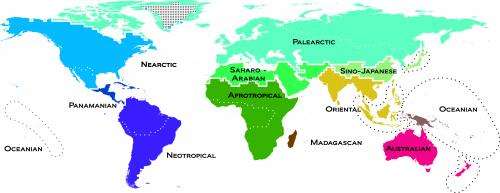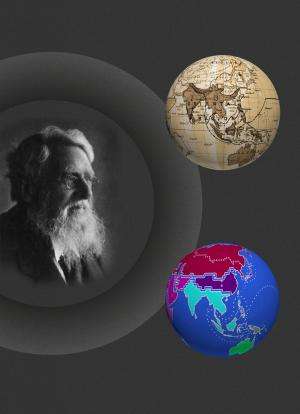This new global map shows the division of nature into 11 large biogeographic realms and shows how these areas relate to each other. Credit: University of Copenhagen
Until today, Alfred Russell Wallace's century old map from 1876 has been the backbone for our understanding of global biodiversity. Thanks to advances in modern technology and data on more than 20,000 species, scientists from University of Copenhagen have now produced a next generation map depicting the organisation of life on Earth. Published online in Science Express today, the new map provides fundamental information regarding the diversity of life on our planet and is of major significance for future biodiversity research.
An essential question in understanding life on Earth is why species are distributed the way they are across the planet. This new global map shows the division of nature into 11 large biogeographic realms and shows how these areas relate to each other. It is the first study to combine evolutionary and geographical information for all known mammals, birds and amphibians, a total of over 20,000 species.
Based on the work at the Center for Macroecology, Evolution and Climate at the University of Copenhagen involving 15 international researchers and 20 years of data compilation, the study is published today in Science Express.
The first attempt to describe the natural world in an evolutionary context was made in 1876 by Alfred Russell Wallace, the co-discoverer of the theory of natural selection, along with Charles Darwin. "Our study is a long overdue update of one of the most fundamental maps in natural sciences. For the first time since Wallace's attempt we are finally able to provide a broad description of the natural world based on incredibly detailed information for thousands of vertebrate species," says co-lead-author, Dr. Ben Holt from the Center for Macroecology, Evolution and Climate.
Alfred Russel Wallace, considered to be the "father of biogeography" and credited with independently discovering evolution by natural selection, along with Charles Darwin. Here he is depicted inspecting two globes, representing his own highly influential global biogeographic map from 1876 (upper) and the updated modern version of this map (lower). Credit: enter for Macroecology, Evolution and Climate
The new map can be split into finer geographical details for each class of animals. It is made freely available to contribute to a wide range of biological sciences, as well as conservation planning and management of biodiversity.
Hundreds of thousands of records
Modern technology like DNA sequencing and a tremendous compilation of hundreds of thousands of distribution records on mammals, birds and amphibians across the globe has made it possible to produce the map.
"The map provides important baseline information for future ecological and evolutionary research. It also has major conservation significance in light of the on-going biodiversity crisis and global environmental change. Whereas conservation planners have been identifying priority areas based on the uniqueness of species found in a given place, we can now begin to define conservation priorities based on millions of years of evolutionary history," says Dr. Jean-Philippe Lessard, the other co-lead-author from the Copenhagen center, who is currently based at McGill University, Canada.
Senior author Carsten Rahbek, director of the Center for Macroecology, Evolution and Climate adds:
"Despite the incredible advances of natural science, we are still battling to understand the underlying laws that govern life on the planet. This holistic description of the natural world that we provide could be a new cornerstone in fundamental biology."
More information: Link to maps: www.macroecology.ku.dk/resources/wallace/
"An Update of Wallace's Zoogeographic Regions of the World," by B.G. Holt, Science, 2012.
Journal information: Science , Science Express
Provided by University of Copenhagen























